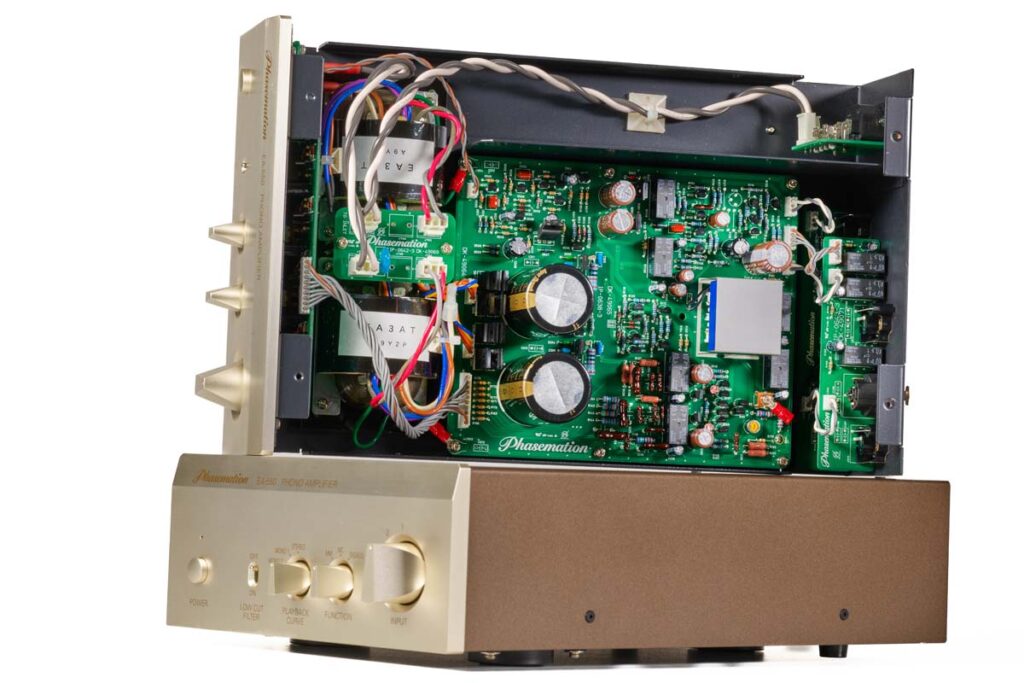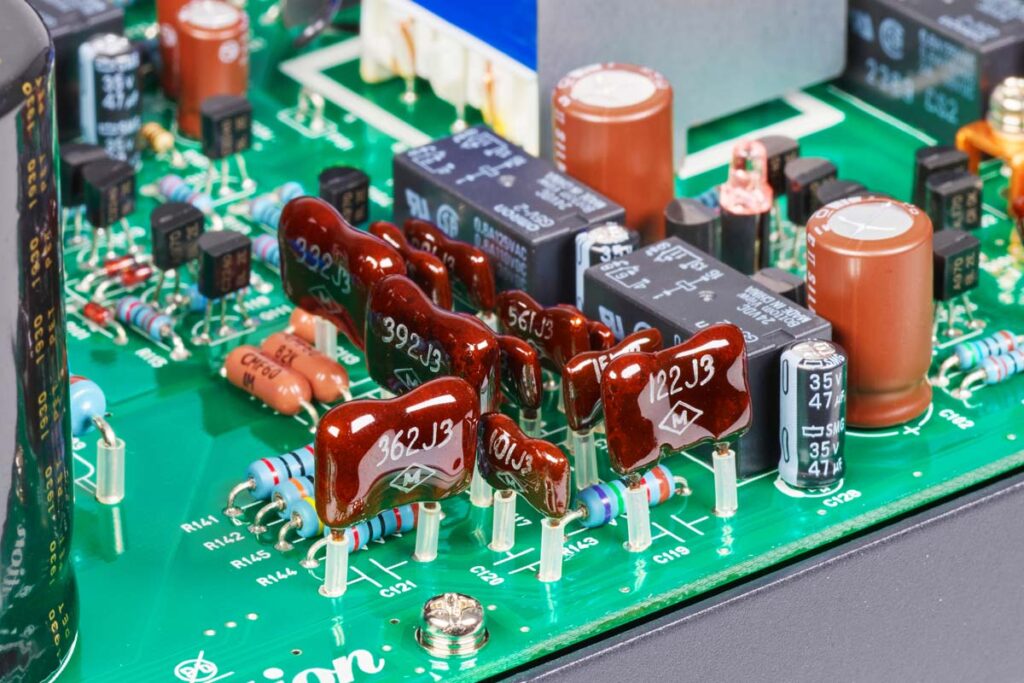As hi-fi fans, whenever we hear the phrase “dual mono”, we immediately think of power amplifiers with powerful performance and sound. This time, however, this thought narrowly misses the mark, as we are dealing with high-class phono preamplification; the following lines show what the entirely symmetrical Phasemation EA-550 can do.
We can spare ourselves the trouble of introducing the Japanese manufacturer Phasemation at this point – we have reported extensively on them and their outstanding products in recent years, as have many others; so I’ll get straight into the technology of the very special Phasemation EA-550 phono amplifier with its integrated transformers.
The art of building this type of amplifier is all about paying particular attention to the power supply. Naturally, two mains cables are required for operation. The enclosures have a 1.6 millimeter thick, copper-coated base – the lid is equipped in the same way. The fronts appear very elegant with their matt champagne-colored aluminum plate and the enclosures are finished to an exemplary standard both inside and out. Each “channel block” not only has a mirror image appearance on the outside, but also on the inside. The settings are essentially self-explanatory, and the feel of the switches is impressive every time you operate them.
This phono amplifier is definitely a model solution for owners of several tonearms/turntables, as the EA-550 allows for up to three tonearms to be connected, two of them via XLR. The latter is basically the correct (electrical) connection type for cartridges, as these are always symmetrical anyway. If you have an appropriate amplifier section, you are completely on the right side when processing the phono signal. The two channels are supplied with corresponding earthing cables – their use needs no further explanation. The earthing ground is located centrally on the respective transformer of the right and left channels, which effectively prevents interference. The two amplifier sections are designed without negative feedback. The components used are of particularly high quality in order to avoid any sound-distorting influences: for example, strictly selected metal film resistors and Silmic electrolytic capacitors from Elna (the Japanese Elna Co. Ltd. designs and manufactures high-quality silk fiber capacitors in its Silmic series, among other things). Silver Mica capacitors ensure the best possible foundation in the respective RIAA equalization. Details on this? Gladly: The dielectric of these components consists of mica, to which pure silver is applied with a dip coating. This treatment leads to an audible improvement in sound, which in short is characterized by more “airiness”.
We wanted to know why the manufacturer uses two separate housings, as there is also the “one-piece” EA-350 phono amplifier, and received this statement from Japan: “Due to the two separate housings, the EA-550 does not produce the crosstalk that would otherwise occur by way of principle. In addition, the signal-to-noise ratio is also improved. As a result, the stereo image and soundstage are considerably better.” The EA-550 offers two transformers per channel (plus and minus side), i.e. a total of four transformers for stereo imaging. This guarantees a fast signal rise time and enables extremely stable mid/bass reproduction. The EA-550 uses exactly the same transformer as the T-1000 step-up transformer (which costs around 4000 euros). The winding wire is made with specially ordered PCOCC and has superior performance in linearity and reproducibility of the miniscule signal. All these details testify to the effort put in at Phasemation to ensure exceptionally good phono signal amplification.
Various setting options are visible on the front, with “Degauss” and the “Low Cut” filter attracting my particular attention. With wavy long-playing records, the low-cut filter prevents a negative influence of the lowest rumble frequencies on the speaker cone. “Degauss” finally puts us on the right track: this can be used to remove unwanted magnetization from connected MC systems (switch on for 30 seconds and that’s it – and to make it clear how effective this simple cure is for such pickups, I’ll just label it ‘necessary’). For fans of historical discs, the “Mono 1”, “Mono 2” and “Stereo” switches are a real stroke of luck, as the first two allow the old Decca and Columbia recordings to be heard a little better thanks to the equalization curves used by these companies at the time. To verify this, I used an LP by John Mayall with Eric Clapton from 1966: recorded in April of that year at Decca Studio No. 2 in London, Blues Breakers delivers details, details, details with the correct equalization!
And that brings us to the crucial issue: I have already mentioned that the EA-550 is finely crafted, but of course the sound quality is the decisive criterion. The necessary cabling was quick and self-explanatory, and while searching for suitable recordings, my eyes fell on Dizzy Gillespie Plays And Raps In His Greatest Concert (Pablo Records, 1982, pressed in red vinyl – a musical bargain that I was recently able to buy for the equivalent of five euros in a record store … in its original packaging!) The Alan Parsons Project then provided the colorful, intense and emotional transition to Patricia Barber in the nightclub with Tales Of Mystery And Imagination – Edgar Allan Poe in a 200-gram pressing. Piano and voice – always a pleasure to listen to, because especially in the quiet passages of such a sound world, you can hear any groove noises quite ruthlessly. And not only these, but also the respective details of voice and piano touches, such as the decay of notes, are shown in a special quality – it’s simply inspiring how the EA-550 ensures calm and order in the reproduction!
The German distributor supplied our test subject with the PP-500 cartridge as a “perfect match”, which I fitted immediately (which was easy to do) and never took off the tonearm again. Not that other cartridges (such as the Dynavector Te Kaitora Rua) would be out of place here, not in the slightest, but using the PP-500 results in such a coherent, synergetic overall picture that the addition of the Phasemation cartridge to the phono stage seems almost obligatory. A particularly good example of this is Apocalyptica Plays Metallica (due to the wide range of frequencies present). Four cellos that are mercilessly driven by the Finnish conservatory-trained musicians into another world of sound, namely that of hard metal, in their very own way. Without the slightest effort, the Phasemation section places the cellos either individually or together in the listening room, which virtually breathes like a resonating body.
Let’s summarize: With the EA-550, Phasemation presents one of the highest quality transistor phono amplifiers ever. Discrete construction throughout and no feedback – without a doubt a reference class phono stage. Three inputs provide the appropriate connections for the discerning phonophile with several turntables/tonearms. Two of the three inputs are XLR versions; the channel-separated design in mirror-balanced, separate housings testifies to the high quality standards. The sound appeals to intellectual and emotional listeners alike. No wonder, because Phasemation succeeds in producing exceptional analog devices that are unique in their sound aesthetics.
Accompanying Equipment
CD transport: Teac P-70 | DAC: Wadia 25 | Turntable: Clearaudio Innovation with power supply Smart Power 24V | Tonearm: Clearaudio Universal | Cartridges: Dynavector Te Kaitora Rua, Clearaudio Charisma V2 | Tube preamplifier: Octave HP 300 SE, Rike Natalija MM/MC 2 | Tube stereo power amplifier: MFE TA 845 with Elrog 284 | Speakers: Blumenhofer Acoustics Genuin FS 1 MK 3 | Cables/accessories: AudioQuest, HMS, GigaWatt circuit breaker, in-akustik
Phono preamplifier Phasemation EA-550
Concept: Dual mono phono preamplifier | Inputs: 1 x RCA, 2 x XLR | Outputs: 3 x RCA | Input sensitivity (MM/MC): 2.5 mV/0.1 mV | Gain (MM/MC): 38 dB/64 dB | Power consumption (operation): approx. 10 W per channel | Dimensions (W/H/D): 21/9/36 cm | Weight: 5.5 kg (per channel) | Warranty period: 2 years | Price: around € 8000
AXISS Europe
Haneckstraße 32
65719 Hofheim
Phone +49 6192 2966434
info@axiss-europe.de










